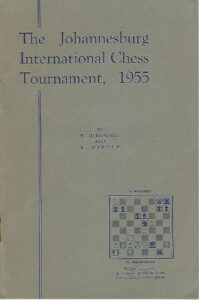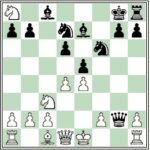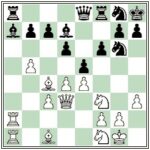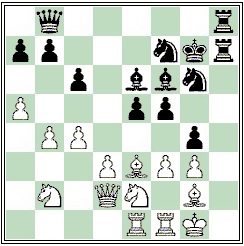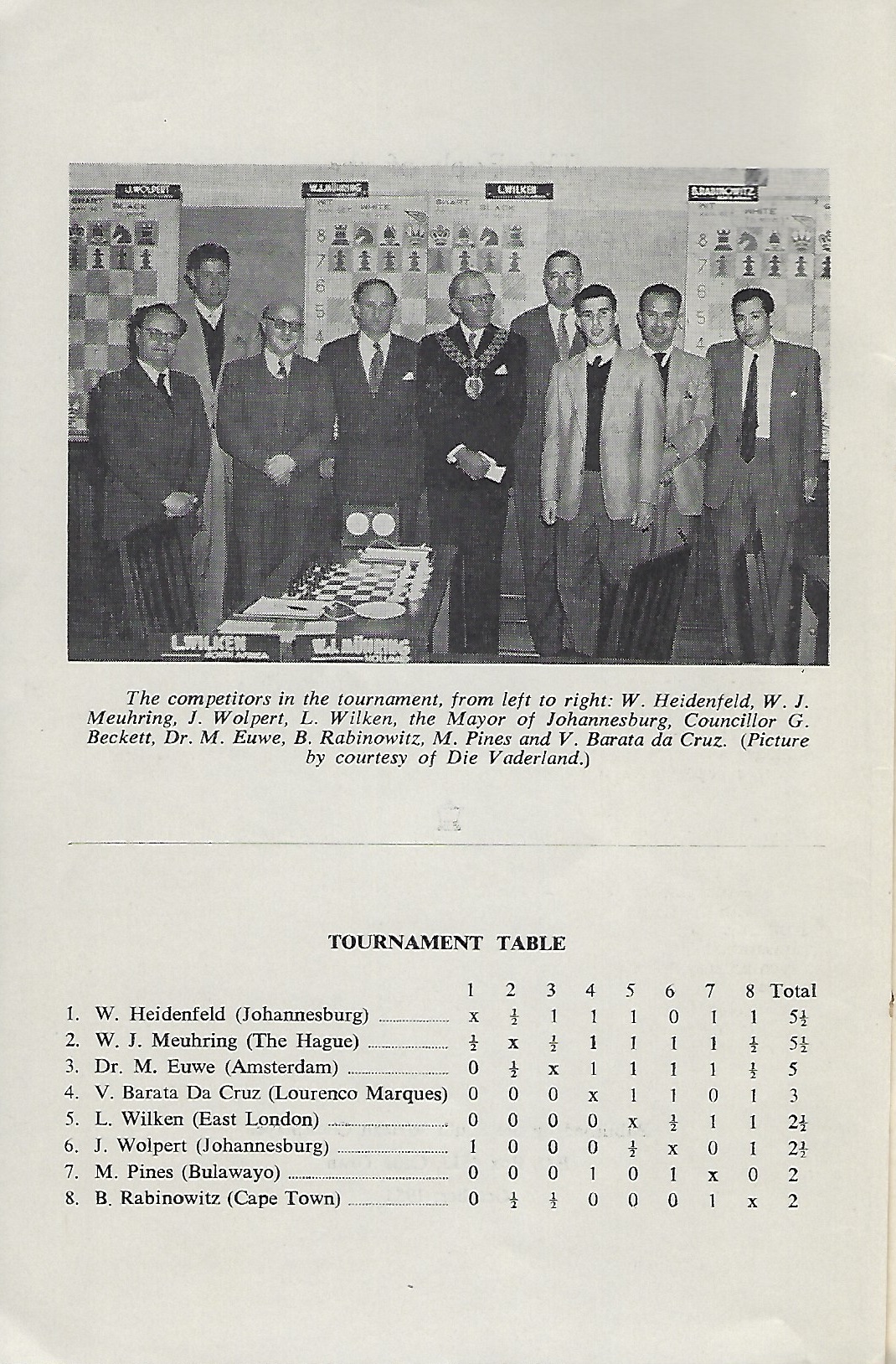In my earlier article Heidenfeld and the 1958 Irish Championship I touched upon the circumstances in which Wolfgang Heidenfeld, German born but resident in South Africa for over 20 years, came to Ireland. In Mark Orr’s broader biographical sketch Wolfgang Heidenfeld 1911-1981, in the section Chess Career, there is this snippet of information:
In 1955 he clinched first place in the last round (#1) of a South African tournament by beating former world champion Max Euwe.
That tournament was the Johannesburg International and Heidenfeld also co-authored the Tournament Book with Kurt Dreyer. (#2)
Heidenfeld got off to a poor start in the tournament, being on the wrong side of a brilliant miniature in Round 1. The division of responsibility between the co-authors had Heidenfeld providing the round-by-round summaries for the tournament book. So here is his own take on that disastrous beginning.
None of this wood-shifting and trench warfare for Heidenfeld and Wolpert! Out into the open field battle marched their armies, with the knights jousting and the bishops and pawns doing their best to follow suit, though historically speaking, they have no business to joust. First Heidenfeld sent a bishop to his early death, for which he exacted the tribute of one of his opponent’s castles. Wolpert seemed to like the idea of levying tributes for the deaths of one’s men and began to offer his in droves, but Heidenfeld, not wanting to be involved in heavy reparations, declined offer after offer. Finally, however, a whisper ran through the ringside audience: “Heidenfeld will be mate in three.” The only one unconcerned was Heidenfeld himself – which was not due to his sangfroid in dangerous positions, but to the simple fact that he had not seen it. For this sporting return to the middle ages Wolpert later received the brilliancy prize.
Wolfgang Heidenfeld — Jack Wolpert
Johannesburg, 1955, Round 1
[Play through the game at ICU website]
1. e4 e5 2. Nf3 d6 3. d4 Nf6 4. Nc3 Nbd7 5. Bc4 Be7 6. Bxf7+ Kxf7 7. Ng5+ Kg8 8. Ne6 Qe8 9. Nxc7 Qg6 10. Nxa8 Qxg2 [Diagram] 11. Rf1 exd4 12. Qxd4 Ne5 13. f4 Nfg4 14. Qd5+ Nf7 15. Qc4 Bh4+ 16. Kd1 Be6 17. Qe2 Nf2+ 18. Rxf2 Bxf2 19. f5 Qg1+ 20. Kd2 Ne5 [We have reached the position featured on the front cover of the Tournament Book ] 21. Nd1 Be1+ 22. Qxe1 Qd4+ and White resigned 0-1
After five rounds Euwe had collected 4.5 points, ahead of fellow-Dutchman, International Master Willem Jan Muehring (#3) on 4.0 and Heidenfeld on 3.5. The latter two had drawn their individual game – here again is Heidenfeld in his best lyrical prose.
With the two Dutch masters in the lead so early in the tournament, the gradually increasing audiences not unreasonably expected superhuman efforts from the South African players in order to catch up with the invaders. The third round was scheduled to be the medium of one of the key games in this effort – and many spectators lounged voluptuously in their comfortable chairs, their eyes glued to the wall-boards, so as to enjoy the tremendous battle that was sure to develop between Muehring and their very own champion, W. Heidenfeld. A grim queen’s pawn was pushed on both sides, gradually warriors of higher rank entered the battle field, amid steadily mounting tension; the white pieces were at their counterparts throats, and vice versa and then at move 11, the climax was reached. Heidenfeld was observed leaning over to his opponent and those near enough distinctly heard him say in German, “Do we have to continue this boring nonsense?” Muehring vehemently agreed that they did not – whereupon both contestants took the rest of the evening off. And thus August 16th will forever be remembered as the date of one of the epic battles of history.
Returning to the situation after Round 5, the tournament appeared set up for a grandstand finish as Max Euwe still had to play his two closest pursuers in the final two rounds. First up for the former world champion was Heidenfeld, to whom we once again turn for an overview of the game.
It all started innocently enough. A slow Giuoco Piano, such as Dr. Euwe must have played scores of times in his tournament practice resulted in a lot of behind-the-scenes manoeuvring on both sides, with knights carrying important messages from one wing to the other and bishops tucked away inconspicuously in the corners. It was one such bishop that caused all the subsequent trouble when, as a result of a superficial move by the grandmaster, he became pinned against a castle, like a moth in an entomologist’s collection. Gradually the whole of the black forces had to be inconvenienced for the sake of this bishop, a stream of pilgrims from all over the world huddled around him, offering their insubstantial prayers, but all to no avail – on the 36th move his fate was sealed, and with it that of the game.
Wolfgang Heidenfeld — Max Euwe
Johannesburg 1955, Round 6
[Play through the game at ICU website]
1. e4 e5 2. Nf3 Nc6 3. Bc4 Bc5 4. c3 Bb6 5. d4 Qe7 6. O-O d6 7. h3 Nf6 8. Re1 O-O 9. a4 a6 10. Na3 Kh8 11. Nc2 Ng8 12. b4 f6 13. Ne3 Ba7 14. Ba3 Qe8 15. Qd3 Nce7 16. b5 axb5 17. axb5 Qh5 18. Nf1 Qe8 19. Re2 Ng6 20. Bc1 Bd7 21. Rea2 [Diagram] Qb8 22. b6 cxb6 23. Bb5 Bxb5 24. Qxb5 N8e7 25. Ne3 Nc8 26. Nd5 Nge7 27. Nxe7 Nxe7 28. dxe5 Nc6 29. exd6 Na5 30. Ba3 Rd8 31. e5 Qc8 32. Bb4 Nc6 33. Qd5 fxe5 34. Nxe5 Nxe5 35. Qxe5 Qb8 36. Qe7 b5 and Black resigned 1-0
Going into the final round it is now Muehring who is in the lead on 5 points with Euwe and Heidenfeld both a half-point behind. After commenting on the Euwe-Muehring encounter which ends in a draw (but not before the less famous Dutchman has missed a study-like win), Heidenfeld’s round report moves on to his own game. The military references this time include a name-check of a legendary 14th century Swiss soldier.
Meanwhile Wilken has played the type of game that Heidenfeld likes best to play against. After a timid opening the East Londoner loses more and more ground on the King-side, where the black infantry soon goose-steps across the equator. Behind it are assembled two rooks, two bishops, two Knights and the King, whilst the chatelaine stays behind to look after the affairs of the Queen-side where all is quiet. So much accumulated force is compressed within a narrow strip of the board that the white army is helpless against the assault when a black Winkelried on KB5 opens a breach; and suddenly the black Queen has joined her army by a flanking movement and it is she who administers the coup de grace. Thus Heidenfeld, scoring 5.5 out of 6 after his initial defeat, has caught Muehring on the finishing line.
Leon Wilken – Wolfgang Heidenfeld
Johannesburg 1955, Round 7
[Play through the game on ICU website]
1.Nf3 Nf6 2.g3 g6 3.Bg2 Bg7 4.0-0 0-0 5.d3 d5 6.Nbd2 Nbd7 7.e4 e5 8.exd5 Nxd5 9.a4 c6 10.a5 f5 11.Nc4 Qc7 12.Ng5 Nc5 13.Bd2 Ne6 14.Nf3 Nd8 15.Re1 Nf7 16.c3 Bd7 17.Qc2 Rae8 18.Bh3 h6 19.Nh4 Kh7 20.Rf1 Bf6 21.Nf3 g5 22.Bg2 Kg7 23.Kh1 Ne7 24.Ng1 Ng6 25.b4 h5 26.Be3 Qb8 27.Rae1 h4 28.Ne2 Rh8 29.Kg1 g4 30.Qd2 Be6 31.Nb2 Rh7 32.c4 Reh8 33.f3 hxg3 34.hxg3 [Diagram] f4 35.gxf4 Nh4 36.fxe5 Bxe5 37.Bf4 Nxg2 38.Bxe5+ Qxe5 39.f4 Qe3+ 40.Qxe3 Nxe3 and White resigned 0-1
(#1) As this article shows, the victory over Euwe was in the penultimate round.
(#2) All Heidenfeld’s games from the tournament can be found in the ICU database. All 28 games from the tournament are available in large databases, e.g. at 365Chess.
(#3) In the tournament Book (other than in the two references on page 2, where Meuhring is incorrectly given) this is the spelling of his name used. I have encountered Muhring in internet searches. In An Illustrated Dictionary of Chess by Edward R. Brace [Hamlyn, 1977] at page 193 the spelling Mühring is given in the entry on the Dutch IM and it may well be that this is the most precise rendering of his name. Muehring is probably an acceptable alternative, as in World Championship Candidate Robert Hübner/Huebner.

